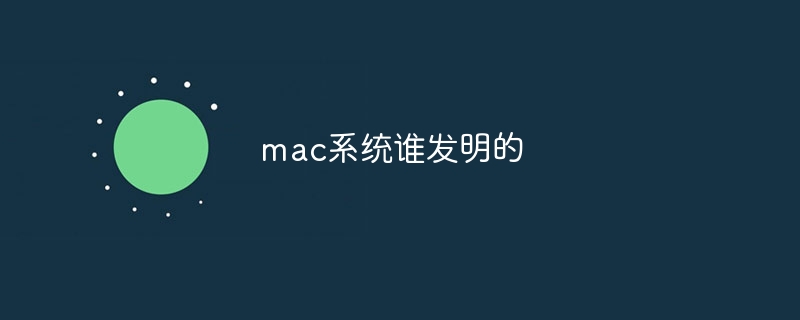Who invented the mac system
The macOS operating system was invented by Apple. Its predecessor, System Software, was launched in 1984. After many iterations, it was updated to Mac OS X in 2001 and changed its name to macOS in 2012.

Who invented the macOS system?
The macOS operating system was developed by Apple.
Detailed description
The macOS system was predecessored by System Software, released by Apple in 1984 for use on Lisa personal computers. In 1987, Apple renamed System Software "Mac OS" and released it with the first-generation Macs.
Over time, Mac OS has undergone several major updates, with the version number growing. In 2001, Apple released Mac OS X, a brand new operating system based on the Unix kernel. Mac OS X was originally called "Mac OS X Public Beta", later renamed "Mac OS X Cheetah", and later renamed "Mac OS X Puma".
Starting in 2005, Apple has made major updates to Mac OS X, including the introduction of Intel-based Macs. In 2012, Apple renamed Mac OS X to macOS and has been used to this day.
Therefore, it can be clearly stated that the macOS system was invented by Apple.
The above is the detailed content of Who invented the mac system. For more information, please follow other related articles on the PHP Chinese website!

Hot AI Tools

Undresser.AI Undress
AI-powered app for creating realistic nude photos

AI Clothes Remover
Online AI tool for removing clothes from photos.

Undress AI Tool
Undress images for free

Clothoff.io
AI clothes remover

AI Hentai Generator
Generate AI Hentai for free.

Hot Article

Hot Tools

Notepad++7.3.1
Easy-to-use and free code editor

SublimeText3 Chinese version
Chinese version, very easy to use

Zend Studio 13.0.1
Powerful PHP integrated development environment

Dreamweaver CS6
Visual web development tools

SublimeText3 Mac version
God-level code editing software (SublimeText3)

Hot Topics
 1378
1378
 52
52
 How to install centos
Apr 14, 2025 pm 09:03 PM
How to install centos
Apr 14, 2025 pm 09:03 PM
CentOS installation steps: Download the ISO image and burn bootable media; boot and select the installation source; select the language and keyboard layout; configure the network; partition the hard disk; set the system clock; create the root user; select the software package; start the installation; restart and boot from the hard disk after the installation is completed.
 Centos options after stopping maintenance
Apr 14, 2025 pm 08:51 PM
Centos options after stopping maintenance
Apr 14, 2025 pm 08:51 PM
CentOS has been discontinued, alternatives include: 1. Rocky Linux (best compatibility); 2. AlmaLinux (compatible with CentOS); 3. Ubuntu Server (configuration required); 4. Red Hat Enterprise Linux (commercial version, paid license); 5. Oracle Linux (compatible with CentOS and RHEL). When migrating, considerations are: compatibility, availability, support, cost, and community support.
 vscode cannot install extension
Apr 15, 2025 pm 07:18 PM
vscode cannot install extension
Apr 15, 2025 pm 07:18 PM
The reasons for the installation of VS Code extensions may be: network instability, insufficient permissions, system compatibility issues, VS Code version is too old, antivirus software or firewall interference. By checking network connections, permissions, log files, updating VS Code, disabling security software, and restarting VS Code or computers, you can gradually troubleshoot and resolve issues.
 How to upgrade HDFS version on CentOS
Apr 14, 2025 pm 07:18 PM
How to upgrade HDFS version on CentOS
Apr 14, 2025 pm 07:18 PM
Upgrading the HDFS version on CentOS: A step-by-step guide to upgrade the Hadoop distributed file system (HDFS) version requires careful action. This article provides a clear step-by-step upgrade guide. Be sure to back up all data before upgrading and carefully read the compatibility requirements and feature descriptions of the new version. Step 1: Prepare a Working Data Backup: This is a crucial step, make sure that all HDFS data is fully backed up. Compatibility check: Verify the compatibility of the new version of Hadoop with existing cluster configurations (operating system, dependencies, etc.). Download the new version: Download the target version software package from the official ApacheHadoop website. Step 2: Stop cluster service Before upgrading, all HDFS must be stopped
 Docker application development
Apr 15, 2025 am 07:03 AM
Docker application development
Apr 15, 2025 am 07:03 AM
Docker application development uses containers to package and deploy applications, providing isolation, portability, consistency, rapid deployment, and version control. The processes include writing code, creating Dockerfiles, building images, running containers, and deploying. Additionally, Docker volumes can be used for data persistence, networks enable secure communication between containers, and orchestration tools can manage large-scale deployments.
 How to choose the PyTorch version on CentOS
Apr 14, 2025 pm 06:51 PM
How to choose the PyTorch version on CentOS
Apr 14, 2025 pm 06:51 PM
When installing PyTorch on CentOS system, you need to carefully select the appropriate version and consider the following key factors: 1. System environment compatibility: Operating system: It is recommended to use CentOS7 or higher. CUDA and cuDNN:PyTorch version and CUDA version are closely related. For example, PyTorch1.9.0 requires CUDA11.1, while PyTorch2.0.1 requires CUDA11.3. The cuDNN version must also match the CUDA version. Before selecting the PyTorch version, be sure to confirm that compatible CUDA and cuDNN versions have been installed. Python version: PyTorch official branch
 What underlying technologies does Docker use?
Apr 15, 2025 am 07:09 AM
What underlying technologies does Docker use?
Apr 15, 2025 am 07:09 AM
Docker uses container engines, mirror formats, storage drivers, network models, container orchestration tools, operating system virtualization, and container registry to support its containerization capabilities, providing lightweight, portable and automated application deployment and management.
 Centos install mysql
Apr 14, 2025 pm 08:09 PM
Centos install mysql
Apr 14, 2025 pm 08:09 PM
Installing MySQL on CentOS involves the following steps: Adding the appropriate MySQL yum source. Execute the yum install mysql-server command to install the MySQL server. Use the mysql_secure_installation command to make security settings, such as setting the root user password. Customize the MySQL configuration file as needed. Tune MySQL parameters and optimize databases for performance.





